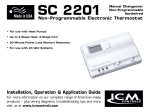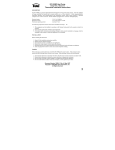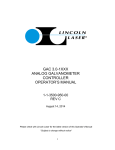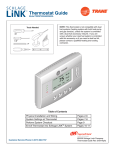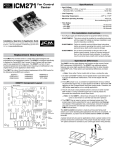Download Coleman 3000 SERIES Specifications
Transcript
SC 2210 3-Stage Heat Pump Manual Changeover Battery or Hardwired Non-Programmable Electronic Thermostat •Configurable •Three Stage Heat Pump Systems •Backlit Display •Field Calibration Feature •Filter Check •Relay Outputs (minimum voltage drop in thermostat) •Ideally Suited for: – Residential (New Construction/Replacement) – Light Commercial Installation, Operation & Application Guide For more information on our complete range of American-made products – plus wiring diagrams, troubleshooting tips and more, visit us at www.icmcontrols.com Table of Contents Parts Diagram........................................................................................................................................................ Specifications......................................................................................................................................................... Important Safety Information................................................................................................................................ Package Contents/Tools Required.......................................................................................................................... To Remove Existing Thermostat........................................................................................................................... To Install Thermostat............................................................................................................................................. Wiring Diagram Conversions.................................................................................................................................. Carrier Split Stream Condensers and Heat Pump Systems................................................................................ Coleman 3000 Series Heat Pump Systems........................................................................................................ ComfortMaker CYC Series Heat Pump Systems................................................................................................ Heil-Quaker 867.814 Series and PH50 Series Heat Pump Systems................................................................... Payne Reliant and Endura Model Heat Pump Systems...................................................................................... Rheem/Ruud: -PGB, -PFA, -PCB, -PLA, and -PKA Series Heat Pump Systems.................................................. Goodman, Janitrol, Trane/American Standard Heat Pumps............................................................................... York -E1CS, -E1FB, -E1FH Heat Pump Systems................................................................................................ Lennox CB19 Heat Pump Systems.................................................................................................................... Lennox HP19 and HP20 Heat Pump Systems.................................................................................................... Lennox HP21 With CB21 PCB Heat Pump Systems........................................................................................... Lennox HP22 With CB19 PCB Heat Pump Systems........................................................................................... FHP 1 Heat Pump Systems................................................................................................................................ FHP 2 Heat Pump Systems................................................................................................................................ Configuration Mode................................................................................................................................................ Terminal Designator Descriptions.......................................................................................................................... SC2210 Output Chart............................................................................................................................................ Starting the Thermostat........................................................................................................................................ LED Indicators....................................................................................................................................................... Testing the Thermostat......................................................................................................................................... Mode of Operation................................................................................................................................................. Troubleshooting..................................................................................................................................................... 1 2 2 2 3 3 5 5 6 7 8 9 10 11 12 13 14 15 16 17 18 19 21 21 21 22 22 24 25 Parts Diagram Specifications Electrical rating: •24 VAC (18-30 VAC) • DC Power: 3.0 VDC (2 “AA” batteries included) •1 amp maximum per terminal • 4 amp maximum total load Temperature control range: 45°F to 90°F (7°C to 32°C) Accuracy: ± 1°F (± 0.5°C) System configurations: 3-stage heat, 2-stage cool heat pump Timing:Anti-short Cycle: 5 minutes Backlight Operation: Battery for 5 seconds, hardwired for 10 seconds Terminations: C, L, R, B, O, W2, G, E, Y1, Y2, W3 Important Safety Information WARNING!: Always turn off power at the main power supply before installing, cleaning, or removing thermostat. •This thermostat is for 24 VAC applications only; do not use on voltages over 30 VAC •All wiring must conform to local and national electrical and building codes •Do not use air conditioning when the outdoor temperature is below 50 degrees; this can damage your A/C system and cause personal injuries •Use this thermostat only as described in this manual Package Contents/Tools Required Package includes: SimpleComfort® 2210 thermostat on base, thermostat cover, wiring labels, screws and wall anchors, Installation, Operation and Application Guide Tools required for installation: Drill with 3/16” bit, hammer, screwdriver To Remove Existing Thermostat ELECTRICAL SHOCK HAZARD – Turn off power at the main service panel by removing the fuse or switching the appropriate circuit breaker to the OFF position before removing the existing thermostat. 1. Turn off power to the heating and cooling system by removing the fuse or switching the appropriate circuit breaker off. 2. Remove cover of old thermostat. This should expose the wires. 3. Label the existing wires with the enclosed wire labels before removing wires. 4. After labeling wires, remove wires from wire terminals. 5. Remove existing thermostat base from wall. 6. Refer to the following section for instructions on how to install this thermostat. To Install Thermostat ELECTRICAL SHOCK HAZARD – Turn off power at the main service panel by removing the fuse or switching the appropriate circuit breaker to the OFF position before removing the existing thermostat. IMPORTANT: Thermostat installation must conform to local and national building and electrical codes and ordinances. Note: Mount the thermostat about five feet above the floor. Do not mount the thermostat on an outside wall, in direct sunlight, behind a door, or in an area affected by a vent or duct. 1. Turn off power to the heating and cooling system by removing the fuse or switching the appropriate circuit breaker off. To Install Thermostat (continued) 2. To remove cover, insert and twist a coin or screwdriver in the slots on the sides of the thermostat. 3. Put thermostat base against the wall where you plan to mount it (Be sure wires will feed through the wire opening in the base of the thermostat). 4. Mark the placement of the mounting holes. 5. Set thermostat base and cover away from working area. 6. Using a 3/16” drill bit, drill holes in the places you have marked for mounting. 7. Use a hammer to tap supplied anchors in mounting holes. 8. Align thermostat base with mounting holes and feed the control wires through wire opening. 9. Use supplied screws to mount thermostat base to wall. 10. Insert stripped, labeled wires in matching wire terminals. See “Wiring Diagrams” section of this manual (Pages 5-18). CAUTION!: Be sure exposed portion of wires does not touch other wires. 11. Tighten screws on terminal block. Gently tug wire to be sure of proper connection. Double check that each wire is connected to the proper terminal. 12. Seal hole for wires behind thermostat with non-flammable insulation or putty, or use an ICM insulated wall plate (ACC-WP01). 13. Replace cover on thermostat by snapping it in place. 14. Turn on power to the system at the main service panel. 15. Test thermostat operation as described in “Testing the Thermostat” (Pages 22-24). Wiring Diagram Conversions SimpleComfort® 2210 Electronic Thermostat Conversion to: Carrier Split Stream Condensers and Heat Pump Systems SC 2210 Electronic Thermostat Carrier Split Stream Low Voltage Terminal Board R Y O G E W2 L C W3 24 VAC, Return Compressor Contactor Reversing Valve (Cooling Mode) Fan Contactor Circuit Emergency Heating Circuit 2nd Stage Heating Circuit System Monitor LED 24 VAC, Common 3rd Stage Heating Circuit SimpleComfort® 2210 Electronic Thermostat Conversion to: Coleman 3000 Series Heat Pump Systems SC 2210 Electronic Thermostat Coleman 3000 Low Voltage Terminal Board R Y B G E W2 L X O 24 VAC, Return Compressor Contactor Reversing Valve (Heating Mode) Fan Contactor Circuit Emergency Heating Circuit 2nd Stage Heating Circuit System Monitor LED 24 VAC, Common SimpleComfort® 2210 Electronic Thermostat Conversion to: ComfortMaker CYC Series Heat Pump Systems Note 1: E and W2 terminals jumpered at thermostat. Note 2: W2 terminal on Comfortmaker capped at PCB. Note 3: X terminal on Comfortmaker capped at PCB. Comfortmaker CYC Low Voltage Terminal Board R Y O G W1 W2 X C SC 2210 Electronic Thermostat 24 VAC, Return Compressor Contactor Reversing Valve (Cooling Mode) Fan Contactor Circuit 2nd Stage Heating Circuit Outdoor Thermostat (Capped) Defrost Sensor (Capped) (capped) (capped) 24 VAC, Common SimpleComfort® 2210 Electronic Thermostat Conversion to: Heil-Quaker 867.814 Series and PH50 Series Heat Pump Systems Note 1: E and W2 terminals jumpered at thermostat. Heil-Quaker 867.814 and PH50 Low Voltage Terminal Board R Y O G W1 W2 C 24 VAC, Return Compressor Contactor Reversing Valve (Cooling Mode) Fan Contactor Circuit 2nd Stage Heating Circuit (Sequencer 1) 3rd Stage Heating Circuit (Sequencer 2) 24 VAC, Common SC 2210 Electronic Thermostat SimpleComfort® 2210 Electronic Thermostat Conversion to: Payne Reliant and Endura Model Heat Pump Systems SC 2210 Electronic Thermostat Payne Reliant and Endura Low Voltage Terminal Board R Y O G E W2 L C W3 24 VAC, Return Compressor Contactor Reversing Valve (Cooling Mode) Fan Contactor Circuit Emergency Heating Circuit 2nd Stage Heating Circuit System Monitor LED 24 VAC, Common 3rd Stage Heating Circuit SimpleComfort® 2210 Electronic Thermostat Conversion to: Rheem/Ruud: -PGB, -PFA, -PCB, -PLA, and -PKA Series Heat Pump Systems Rheem/Ruud PGB, PFA, PCB, PLA, PKA Low Voltage Terminal Board SC 2210 Electronic Thermostat 10 R Y B G W2 L X O 24 VAC, Return Compressor Contactor Reversing Valve (Heating Mode) Fan Contactor Circuit 2nd Stage Heating Circuit System Monitor LED 24 VAC, Common SimpleComfort® 2210 Electronic Thermostat Conversion to: Goodman, Janitrol, Trane/American Standard Heat Pumps Goodman, Janitrol, Trane/American Standard Low Voltage Terminal Board Note 1: E and W2 terminals jumpered at thermostat. Note 2: X2 terminal capped at PCB. Note 3: T terminal capped at PCB. R Y O G 24 VAC, Return Compressor Contactor Reversing Valve (Cooling Mode) Fan Contactor Circuit (capped) X2 W-U B T SC 2210 Electronic Thermostat 2nd Stage Heating Circuit 24 VAC, Common (capped) 11 SimpleComfort® 2210 Electronic Thermostat Conversion to: York -E1CS, -E1FB, -E1FH Heat Pump Systems Note 1: E and W2 terminals jumpered at thermostat. York -E1CS, -E1FB, -E1FH Low Voltage Terminal Board R 12 Y O G W X B 24 VAC, Return Compressor Contactor Reversing Valve (Cooling Mode) Fan Contactor Circuit 2nd Stage Heating Circuit System Monitor LED 24 VAC, Common SC 2210 Electronic Thermostat SimpleComfort® 2210 Electronic Thermostat Conversion to: Lennox CB19 Heat Pump Systems SC 2210 Electronic Thermostat Lennox CB19 Low Voltage Terminal Board R Y O G E W1 L C T 24 VAC, Return Compressor Contactor Reversing Valve (Cooling Mode) Fan Contactor Circuit Emergency Heating Circuit 2nd Stage Heating Circuit System Monitor LED 24 VAC, Common (capped) 13 SimpleComfort® 2210 Electronic Thermostat Conversion to: Lennox HP19 and HP20 Heat Pump Systems SC 2210 Electronic Thermostat Lennox HP19 and HP20 Low Voltage Terminal Board V-VR 14 M R F E Y X 24 VAC, Return Compressor Contactor Reversing Valve (Cooling Mode) Fan Contactor Circuit Emergency Heating Circuit 2nd Stage Heating Circuit 24 VAC, Common SimpleComfort® 2210 Electronic Thermostat Conversion to: Lennox HP21 With CB21 PCB Heat Pump Systems SC 2210 Electronic Thermostat Lennox HP21 with CB21 PCB Low Voltage Terminal Board R-VR Y1 O F E W1 L X Y2 24 VAC, Return Compressor Contactor Reversing Valve (Cooling Mode) Fan Contactor Circuit Emergency Heating Circuit 2nd Stage Heating Circuit System Monitor LED 24 VAC, Common 2nd Stage Cooling Circuit 15 SimpleComfort® 2210 Electronic Thermostat Conversion to: Lennox HP22 With CB19 PCB Heat Pump Systems SC 2210 Electronic Thermostat Lennox HP22 with CB19 PCB Low Voltage Terminal Board R-VR M R F E Y L X Y2 16 24 VAC, Return Compressor Contactor Reversing Valve (Cooling Mode) Fan Contactor Circuit Emergency Heating Circuit 2nd Stage Heating Circuit System Monitor LED 24 VAC, Common 2nd Stage Cooling Circuit SimpleComfort® 2210 Electronic Thermostat Conversion to: FHP 1 Heat Pump Systems Note: For units with ECM motors and the 641-065 interface board, connect W2 from the thermostat to the W1 at the heat pump. FHP 1 Stage HP Low Voltage Terminal Board R Y O G E W C SC 2210 Electronic Thermostat 24 VAC, Return Compressor Contactor Reversing Valve (Cooling Mode) Fan Contactor Circuit Emergency Heating Circuit 2nd Stage Heating Circuit 24 VAC, Common 17 SimpleComfort® 2210 Electronic Thermostat Conversion to: FHP 2 Heat Pump Systems Note 1: Jumper from W2 to Y2 for 2 compressor systems without electric heat. FHP 2 Stage HP Low Voltage Terminal Board R Y O G C Y2 18 24 VAC, Return Compressor 1 Contactor Reversing Valve (Cooling Mode) Fan Contactor Circuit 24 VAC, Common Compressor 2 Contactor SC 2210 Electronic Thermostat Configuration Mode The configuration mode is used to set the SC2210 to match your heating/cooling system. The SC2210 functions with up to 3-stage heat pump systems. To configure the SC2210, perform the following steps: 1. Slide the Mode switch to the OFF position. 2. Remove the cover of the thermostat by gently pulling on one of the corners. 3. Simultaneously hold the SW5 and SW6 buttons in for 5 seconds while the SC2210 is in OFF mode. 4. Press the or button to change settings within each screen. 5. Press the SW6 button to advance to the next screen. Note: The SW5 button will return you to the previous screen. 6. To exit configuration mode, slide the Mode switch to Heat or Cool. Configuration Mode Settings The setup screens for Configuration Mode are as follows: 1. Temperature Scale (F or C) – Choose Fahrenheit or Celsius. Press the or button to select. Press the SW6 button to advance to the next screen. 2. Temperature Differential – Stage 1 – (1°F to 3°F) (0.5°C to 1.5°C) – Set the number of degrees between your “setpoint” temperature and your “turn on” temperature for first stage. Press the or button to set differential value. Press the SW6 button to advance to the next screen. 3. Temperature Differential – Stage 2 – (1°F to 6°F) (0.5°C to 3.0°C) – Set the number of degrees between when stage 1 turns on and stage 2 turns on. Press the or button to set differential value. Press the SW6 button to advance to the next screen. SET ROOM REMOTE DIFF FILTER SET ROOM REMOTE DIFF FILTER SET ROOM DIFF FILTER SET ROOM REMOTE DIFF FILTER REMOTE SET ROOM REMOTE DIFF FILTER 19 4. Temperature Differential – Stage 3 – (1°F to 6°F) (0.5°C to 3.0°C) – Set the number of degrees between when stage 2 turns on and stage 3 turns on. Press the or button to set differential value. Press the SW6 button to advance to the next screen. 5. Staged Off Outputs Select whether the outputs for heating and cooling are staged off independently or are satisfied simultaneously. 1 = Economy Mode – Outputs are staged on and off in accordance with set point and differential. 0 = Comfort Mode – Outputs are staged on and and all stages cycle off simultaneously when set point is satisfied. SET ROOM SET ROOM SET ROOM REMOTE DIFF FILTER REMOTE DIFF FILTER 6. Minimum Cool Setpoint (45°F to 75°F) (7°C to 24.0°C) Adjust to control the minimum Cool set temperature allowed. Press the or button to select. Press the SW6 button to advance to the next screen. SET ROOM 7. Maximum Heat Setpoint (55°F to 90°F) (13°C to 32°C) Adjust to control the maximum Heat set temperature allowed. Press the or button to select. Press the SW6 button to advance to the next screen. SET ROOM 8. Room temperature offset (+9°F to -9°F) (+4.5°C to -4.5°C) Adjust to calibrate displayed room temperature to match actual room temperature. Note: When not set to 0, ROOM will display Press the or button to select. Press the SW6 button to advance to the next screen. 9. Maximum compressor cycles allowed per hour (-, 2-6) - = as many as needed, 2-6 = maximum cycles/hour Press the or button to select. Press the SW6 button to advance to the next screen. 20 REMOTE DIFF FILTER REMOTE DIFF FILTER DIFF FILTER SET ROOM REMOTE DIFF FILTER REMOTE SET ROOM REMOTE DIFF FILTER SET ROOM REMOTE DIFF FILTER SET ROOM DIFF FILTER REMOTE 10. Filter Check time (300-800, – – –) Set Fan Run Time (in hours) when Check Filter is displayed or set to – – – to disable. Press the or button to select. Note: After exiting configuration mode, to reset filter counter to zero and clear filter warning, press the and button simultaneously for 5 seconds. Press the SW6 button to review settings. Slide the Mode switch to Heat or Cool to exit configuration. SET ROOM REMOTE DIFF FILTER (800 Hours) Terminal Designator Descriptions R – 24 VAC hot C – 24 VAC common O – cool active reversing valve B – heat active reversing valve Y1 – 1st stage cool, 1st stage heat W2 – 2nd stage heat Y2 – 2nd stage cool for 2 compressor systems G – Fan W3 – 3rd stage heat L – Check indicator E – 1st stage emergency SC2210 Output Chart Heat Pump Emergency Heat HP 1ST Cool 2ND Cool 1ST Heat 2ND Heat 3RD Heat Y1, G, O Y1, Y2, G, O Y1, G, B Y1, W2, G, B Y1, W2, W3, G, B N/A N/A E, G E, W2, G E, W2, W3, G Starting the Thermostat CAUTION!: Do not use air conditioning when the outdoor temperature is below 50 degrees. This can damage your air conditioning system and cause personal injuries. 1. Move the Fan Auto/On switch to the Auto position. 2. Move the Cool/Off/Heat/Emer switch to Cool or Heat, depending on the season. SET ROOM DIFF FILTER REMOTE 21 LED Indicators There are three LED indicators located on the front of the thermostat. They are designed to inform you about the following: LED Color AUX Green Function CHECK Red •When this turns on, a malfunction has occurred somewhere in the heat pump system •Please contact a qualified service technician as soon as possible to check your system EMER Red •This light turns on whenever the emergency heat is manually selected (Mode switch is in the EMER position) •While in the emergency Heat mode, the heat pump compressor is off, and the emergency heat (same as the auxiliary heat) maintains the setpoint temperature •This turns on when the auxiliary (second stage) heating is in operation •It turns on 1-6°F below first stage and is user adjustable (see Configuration, Step 3, Page 19) Testing the Thermostat Once the thermostat is installed, it should be thoroughly tested. CAUTION!: Do not energize the air conditioning system when the outdoor temperature is below 50 degrees. It can result in equipment damage or personal injury. 22 Cool Test 1. Slide Mode switch to Cool mode. 2. Adjust set temperature so it is 5 degrees below room temperature. 3. Air conditioning should come on within a few seconds. 4. Adjust the set temperature 2 degrees above the room temperature and the A/C should turn off. There may be a fan delay on your system. Note: There is a five minute time delay to protect the compressor after it turns off. To temporarily bypass the five minute delay, slide the Mode switch to OFF for 2 seconds and then back to Cool. Cool Off Heat Emer Heat Test 1. Slide Mode switch to Heat mode. 2. Adjust the set temperature so it is 5 degrees above the room temperature. 3. Heat should come on within a few seconds. Cool Off Heat Emer 4. Adjust the set temperature so it is 2 degrees below the room temperature and the heat should turn off. There may be a fan delay on your system. Note: There is a five minute time delay to protect the compressor after it turns off. To temporarily bypass the five minute delay, slide the Mode switch to OFF for 2 seconds and then back to Heat. Emergency Heat Test 1. Slide Mode switch to Emer position (Emer LED lights). 2. Adjust the set temperature so it is 5 degrees above the room temperature. There may be a five minute delay. 3. Second stage heat should come on (Aux LED lights). 4. Adjust the set temperature so it is 2 degrees below the room temperature. Heat should turn off. There may be a fan delay on your system. (Testing the thermostat continued on Page 24) Cool Off Heat Emer 23 (Testing the thermostat continued from Page 23) Fan Test 1. Slide Fan switch to On position. 2. Indoor fan turns on. 3. Slide Fan switch to Auto position. 4. Indoor fan turns off. Auto On Auto On Mode of Operation The SC2210 is a multi-stage, heat pump thermostat. The SC2210 can use 24 VAC or batteries as a power supply. The SC2210 can be hardwired and have no batteries installed in the battery compartment. It can also run on battery power only. When batteries are installed and the thermostat is hardwired, the batteries will run the thermostat during a power outage. When operating on battery power, the backlight will be on for 5 second intervals. When hardwired, the backlight will be on for 10 second intervals. The thermostat activates the heat pump when the room temperature is below the heat set temperature (by the differential temperature). Auxiliary heat will be activated if the room temperature continues to drop. Third stage heat is activated (on some systems) if the temperature drops further. The heat outputs are staged off (configurable, setting 5, Page 20) as the room temperature increases. The thermostat will not let the compressor come on for five minutes after it turns off. This protects your compressor. When the room temperature is greater than the cool set temperature (by the differential temperature), the cooling device is activated. Second-stage cooling will be activated if the room temperature continues to rise. The cool outputs are staged off (configurable, setting 5, Page 20) as the room temperature decreases. The thermostat will not let the compressor come on for five minutes after it turns off. This protects your compressor. The SC2210 has the following operating modes: OFF, Heat, Emergency Heat and Cool. In OFF mode, the thermostat will not turn on heating or cooling devices. In the Heat mode, the thermostat controls the heat pump system. In the Emergency Heat mode, the heat pump is bypassed and auxiliary becomes the primary heat source. In the Cool mode, the thermostat controls the cooling system. The indoor fan can be turned on in all operating modes using the Fan switch. The SC2210 has an air filter check option also. When the fan run time exceeds the time set in the configuration (step 10, page 21), the filter reminder will be displayed. To reset the filter counter to zero and clear the filter reminder from the display, press the and buttons in simultaneously for 5 seconds. 24 Troubleshooting Symptom No display System fan does not come on properly Thermostat turns on and off too frequently Fan runs continuously Room temperature is not correct ROOM displays filter displays Auxiliary heat not on soon enough Problem not listed above Remedy For Hardwired Installation Check for 24 VAC at thermostat; display is blank when 24 VAC is not present For Battery Installation Display is blank when batteries are drained or installed incorrectly Verify wiring is correct Adjust temperature differential (see “Temperature Differential,” Stage 1, Step 2, Page 19) Check fan On/Auto switch, ON position runs indoor fan continuously Verify wall hole is plugged with putty or insulation; calibrate thermostat (see “Configuration,” Step 8, Page 20) Room temperature offset is not zero (see “Configuration,” Step 8, Page 20) Fan run time has exceeded filter check time set in configuration (see “Configuration,” Step 10, Page 21) To reset counter to zero and clear filter warning, press the and button simultaneously for 5 seconds Adjust differential for 2nd and 3rd stage heating if required (see Configuration, Steps 3 and 4, Pages 19-20) Press the Reset button once; display will be refreshed and anti-short cycle timing will be reset to zero 25 ONE-YEAR LIMITED WARRANTY The Seller warrants its products against defects in material or workmanship for a period of one (1) year from the date of manufacture. The liability of the Seller is limited, at its option, to repair, replace or issue a non-case credit for the purchase prices of the goods which are provided to be defective. The warranty and remedies set forth herein do not apply to any goods or parts thereof which have been subjected to misuse including any use or application in violation of the Seller’s instructions, neglect, tampering, improper storage, incorrect installation or servicing not performed by the Seller. In order to permit the Seller to properly administer the warranty, the Buyer shall: 1) Notify the Seller promptly of any claim, submitting date code information or any other pertinent data as requested by the Seller. 2) Permit the Seller to inspect and test the product claimed to be defective. Items claimed to be defective and are determined by Seller to be non-defective are subject to a $30.00 per hour inspection fee. This warranty constitutes the Seller’s sole liability hereunder and is in lieu of any other warranty expressed, implied or statutory. Unless otherwise stated in writing, Seller makes no warranty that the goods depicted or described herein are fit for any particular purpose. Patent No. 424,953 7313 William Barry Blvd., North Syracuse, NY 13212 (Toll Free) 800-365-5525 (Phone) 315-233-5266 (Fax) 315-233-5276 www.icmcontrols.com LIA200-2




























